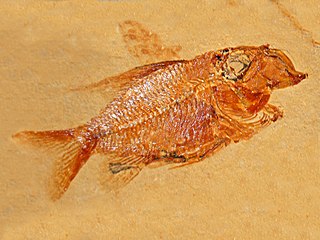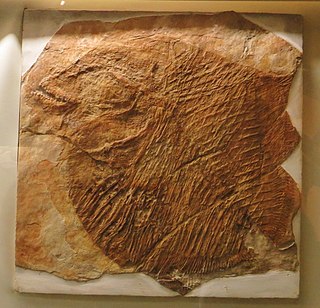
The beardfishes consist of a single extant genus, Polymixia, of deep-sea marine ray-finned fish named for their pair of long hyoid barbels. They are classified in their own order Polymixiiformes. But as Nelson says, "few groups have been shifted back and forth as frequently as this one, and they were recently added to Paracanthoptergii". For instance, they have previously been classified as belonging to the Beryciformes, and are presently considered either paracanthopterygians or the sister group to acanthopterygians. They are of little economic importance.

Diplomystus is an extinct genus of freshwater and marine clupeomorph fish distantly related to modern-day extant herrings, anchovies, and sardines. It is known from the United States, China, and Lebanon from the Late Cretaceous to the middle Eocene. Many other clupeomorph species from around the world were also formerly placed in the genus, due to it being a former wastebasket taxon. It was among the last surviving members of the formerly-diverse order Ellimmichthyiformes, with only its close relative Guiclupea living for longer.

Cimolichthys is an extinct genus of large predatory marine aulopiform ray-finned fish known worldwide from the Late Cretaceous. It is the only member of the family Cimolichthyidae.

Apateodus is a genus of prehistoric marine ray-finned fish which was described by Woodward in 1901. It was a relative of modern lizardfish and lancetfish in the order Aulopiformes, and one of a number of prominent nektonic aulopiforms of Cretaceous marine ecosystems.

Bananogmius is an extinct genus of marine ray-finned fish that was found in what is now North America and Europe during the Late Cretaceous, from the Cenomanian to the Santonian. It lived in the Western Interior Seaway, which split North America in two during the Late Cretaceous, as well as the proto-North Sea of Europe.
Acrogaster is a genus of fossil marine fish in the order Trachichthyiformes, known from the Late Cretaceous period. Species are known from Germany and Lebanon.

Anguillavus is an extinct genus of basal marine eel that lived during the upper Cenomanian of Lebanon. It is the only known member of the family Anguillavidae. Its primitive nature compared to extant eels is indicated by it still retaining its pelvic fins, which have been lost in modern eels.

Dastilbe is an extinct genus of prehistoric marine & freshwater ray-finned fish from the Early Cretaceous of Brazil. It was a relative of modern milkfish.

Alloberyx is an extinct genus of prehistoric marine ray-finned fish, possibly a holocentrid, that lived during the Santonian of Lebanon, from the Sahel Alma site. It contains two species, A. syriacus, initially described as a species of Pseudoberyx, and A. robustus, initially classified in the genus Serratocentrus.
Cryptoberyx is an extinct genus of prehistoric marine ray-finned fish that lived during the late Cenomanian stage of the Late Cretaceous. Two species are known from southern Europe and the Middle East, both part of the former Tethys Sea.

Lissoberyx is an extinct genus of prehistoric ray-finned fish belongon to the family Trachichthyidae. Lissoberyx is a trachichthyid, but it shows more resemblance to the holocentrids than any other trachichthyid.
Barcarenichthys is an extinct genus of prehistoric marine ray-finned fish that lived during the Late Cretaceous. It contains a single species, B. joneti, from the late Cenomanian of Portugal.
Adriacentrus is an extinct genus of prehistoric marine bony fish that lived in the Turonian in what is now Croatia. It contains a single species, A. crnolataci. Formerly considered a beryciform fish, it is now known to be more closely related to the squirrelfish (Holocentridae).

Ctenothrissa is a prehistoric genus of marine ray-finned fish in the order Ctenothrissiformes. It contains a number of species known from the Late Cretaceous of England and Lebanon.

Coelodus is an extinct genus of marine and possibly freshwater pycnodont fish. It contains only one definitive species, C. saturnusHeckel, 1854, from the Late Cretaceous of Slovenia. Other species from the Late Jurassic to the Eocene have also been attributed to this genus based on isolated dental elements, but their assignment to Coelodus is uncertain, and this genus likely represents a non-monophyletic wastebasket taxon. A potential diagnostic trait is a prearticular tooth row with three regular highly elongated teeth.
Clupavus is an extinct genus of marine ray-finned fish that lived during the middle of the Cretaceous period. It is known from North Africa, Europe, Brazil, and possibly North America.
Charitosomus is an extinct genus of prehistoric marine ray-finned fish from the Late Cretaceous, related to modern beaked salmons. They were nektonic carnivores in life.
Caeus is an extinct genus of prehistoric marine ray-finned fish, closely related to the modern milkfish. It contains a single species, C. leopoldi from the Early Cretaceous of the Pietraroja Plattenkalk, Italy. It is one of the largest teleosts known from the Pietraroja formation, and is known by only a single specimen.

Cylindracanthus is an extinct, enigmatic genus of marine ray-finned fish with fossils known throughout North America, Europe, Asia and Africa from the Late Cretaceous to the late Eocene, with potential Oligocene records and a possible Miocene record also known. It is exclusively known from its distinctive partial remains, which are long cylindrical bony spines that are usually considered rostrum fragments, as well as some associated teeth. These spines are abundant & widespread throughout this timespan, and are useful indicators of a nearshore marine environment, but the taxonomic identity of the fish is still highly uncertain and debated.

Tselfatiiformes is an extinct order of bony fishes from the infraclass Teleostei. The order represents the most important radiation of marine teleosts during the Cretaceous period. Fossils of tselfatiiforms are known from Europe, North America, central and northern South America, the Middle East and North Africa.












